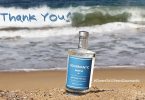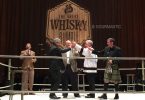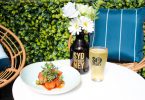After the Rosé and Pink Fish masterclass at Three Winos and a Fishtale, it was time for Shellfish and the 3 S’s: Sancerre, Semillon & Shampoo. Co-presented by renowned wine writer Mike Bennie and John Susman of Fishtales and Cloudy Bay Fish Co, the session focussed on shellfish and the traditional wine accompaniments.

Shellfish and the 3 S’s: Sancerre, Semillon & Shampoo
NV Laurent Perrier Ultra Brut Champagne, France – Whisperes Choice Broken Bay Pacific Oyster
NV Laurent Perrier Ultra Brut Champagne is a dry style that the house of Laurent Perrier pioneered some 150 year ago. Made from 55% Pinot Noir and 45% Chardonnay, it’s bone dry with zero dosage, characteristics that gives it longevity, texture and flavour. The aperitif-style wine is thirst-quenching and refreshes the palate in between sips.
Champagne and oysters are a traditional pairing, and much like wine, oysters are most reflective of their terroir. In their micro-climate, they pump about 40L of water in and out of their body per day and they eat up to 50,000 bits of food depending on the species. The flavour of the oyster is therefore based on that micro-climate which has a high saline environment, a lot of food and high oxygen levels for optimum growing conditions. The Pacific Oyster from Broken Bay has that flavour profile, with a saline bite but a depth of flavour, a creaminess and a sweetness often found in a Sydney Rock Oyster.
With Whisperes Choice Pacific Oyster, it is about the effinage or the finishing in the last 3 weeks that gives it its flavour. The artisan grower assesses the water, the climate, the conditions and moves the oysters around to an area of the highest food to finish them properly. In Australia, oysters are harvested when they are about to spawn, hence their rich and creamy nature whereas in France it is the reverse which gives them a more briny character.
When it comes to this traditional pairing, the minerality and dryness of the champagne lends itself to the creamy texture of the oyster.
2012 Lisa McGuigan Semillon, Hunter Valley – Cloudy Bay Diamond Shell Clam
The next wine is a Hunter Valley Semillon by Lisa McGuigan who has recently started her own label creating wines sourced from her family’s vineyards. The 2012 Lisa McGuigan Semillon is very young and very fresh, a “wine of vitality and youth” that works very well with shellfish and seafood in general.
Cloudy Bay Diamond Shell Clam is the match, a clam that never spends any of its life out of the water so it has a maximum glycogen load. Its flavour profile is very sweet, with a savoury back palate and no bitter notes. Clams are in essence 95% meat and 5% gonads unlike oysters which are the reverse – a fact that makes a good discussion as to which wine is more suited.
The Noosa Spanner Crab is also on taste, a type of crab that sits below the surface of the sand on the seabed. Its entire diet consists of scallop, prawn and lobster which is reflected in the sweetness and clean flavour of the crab meat. Again, the shellfish and wine combination are complementary.
The semillon is said to be “firm”, almost verjuice-like which is a condition of a very wet season and makes a good match with the meaty clams that are eaten raw and offsets the sweetness of the spanner crab.
2010 Eric Louis Sancerre, Loire Vallée, France – Shar Bay Seafoods North West Shelf Scampi
The last wine is a traditional Sancerre from the west coast of France. Eric Louis Sancerre is a 9th generation producer of wine with the family traced back to 1600s. In that coastal region, the soil is very rich in minerals with little clay and limestone which results in a mineral-inflected wine. As a very dry style, it is suitable to refreshing the palate in between mouthfuls of food and is the traditional match with seafood on the west coast of France.
Shar Bay Seafoods North West Shelf Scampi come from the north west shelf of the Kimberly coast. The scampi live in burrows and mudflats and eat garbage which is what makes them delicious. These shellfish are incredibly sweet, rich in flavour with an intense front palate and a clean back palate which pair well with the dryness of the Sancerre.
Experimenting with the different seafood and wine matches concluded that the sweetness and richness of the shellfish is best counterbalanced with the dryness and higher acidity of the wines which have high minerality.
The Shellfish and the 3 S’s Masterclass was held during Three Winos and a Fishtale trade event on Monday 6 August 2012.






Oh man you are just too lucky Corinne, you get to attend so many fantastic events! Well, you had me at Sancerre… sounds like a wonderful match for all that yummy shellfish 🙂
[…] also Shellfish and the 3 S’s: Sancerre, Semillon & Shampoo Masterclass with Mike Bennie & John …. Corinne (Ms Gourmantic) is the founder and editor of Gourmantic. She has a strong penchant for […]
[…] Mike Bennie […]
[…] masterclasses were hosted on the day including Rosé – Pearls and Pink Fish and Shellfish and the 3 S’s – Sancerre, Semillon and Shampoo by Mike Bennie and John […]